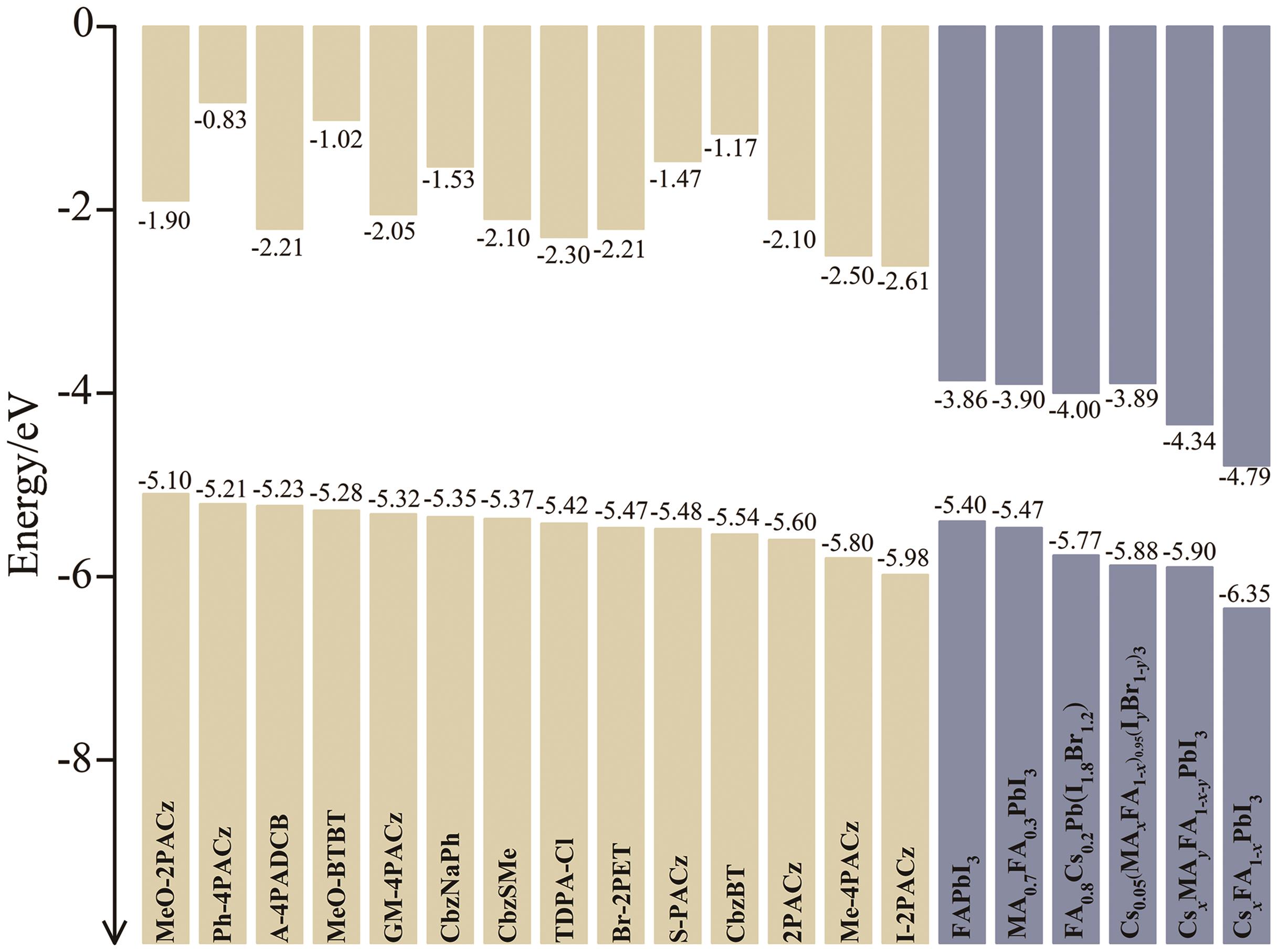
应用化学 ›› 2025, Vol. 42 ›› Issue (5): 597-620.DOI: 10.19894/j.issn.1000-0518.240418
• 综合评述 •
自组装单分子层在反式钙钛矿太阳能电池中的研究进展
- 1.(南京工业大学柔性电子(未来技术)学院,南京 211816 )
2.华南理工大学发光材料与器件国家重点实验室,广州 510641
-
收稿日期:2024-12-18接受日期:2025-04-03出版日期:2025-05-01发布日期:2025-06-05 -
通讯作者:王芳芳,黄维 -
作者简介:第一联系人:共同第一作者 -
基金资助:国家自然科学基金面上项目(62474091);江苏省自然科学基金面上项目(BK20241871);江苏省高等学校基础科学研究重大项目(24KJA480003)
Research Progress of Self-Assembled Monolayers in Inversed Perovskite Solar Cells
Lei LI1, Meng-Zhu DING1, Fang-Fang WANG1,2( ), Wei HUANG1(
), Wei HUANG1( )
)
- 1.(School of Flexible Electronics (Future Technology),Nanjing Tech University,Nanjing 211816,China )
2.State Key Laboratory of Luminescent Materials and Devices,South China University of Technology,Guangzhou 510641,China
-
Received:2024-12-18Accepted:2025-04-03Published:2025-05-01Online:2025-06-05 -
Contact:Fang-Fang WANG,Wei HUANG -
About author:iamffwang2@njtech.edu.cn; iamwhuang@njtech.edu.cn
-
Supported by:the National Natural Science Foundation of China(62474091);the Natural Science Foundation of Jiangsu Province(BK20241871);the Major Basic Science Research Project of Jiangsu Colleges and Universities(24KJA480003)
摘要:
钙钛矿太阳能电池以其优异的光电转换效率、低廉的制造成本和简便的制备工艺而备受瞩目,有望成为下一代光伏技术。 然而,其长期稳定性问题和潜在的铅泄漏风险严重阻碍了其商业化进程。 反式钙钛矿太阳能电池(iPSCs)凭借其优异的稳定性,成为研究热点。 自组装单分子层(SAMs)作为一种新型的空穴选择层(HSL)材料,因其定制化的分子剪裁策略和优异的界面调控能力,为解决iPSCs的稳定性和效率问题提供了新的途径。 本文综述了SAMs在iPSCs中的应用进展,详细讨论了SAMs的分子结构设计、沉积方法以及其在能级调控、缺陷钝化和界面改性方面的作用机制。 此外,本文还探讨了顺序沉积和共组装(Co-SAMs)策略以进一步提升器件性能。 最后,对SAMs技术面临的挑战和未来的发展方向进行了展望,包括大面积制备、长期稳定性提升、成本降低以及新型SAMs分子的设计等。 SAMs技术有望推动iPSCs的高效、稳定和低成本商业化,为清洁能源的可持续发展做出贡献。
中图分类号:
引用本文
李磊, 丁梦竹, 王芳芳, 黄维. 自组装单分子层在反式钙钛矿太阳能电池中的研究进展[J]. 应用化学, 2025, 42(5): 597-620.
Lei LI, Meng-Zhu DING, Fang-Fang WANG, Wei HUANG. Research Progress of Self-Assembled Monolayers in Inversed Perovskite Solar Cells[J]. Chinese Journal of Applied Chemistry, 2025, 42(5): 597-620.
使用本文
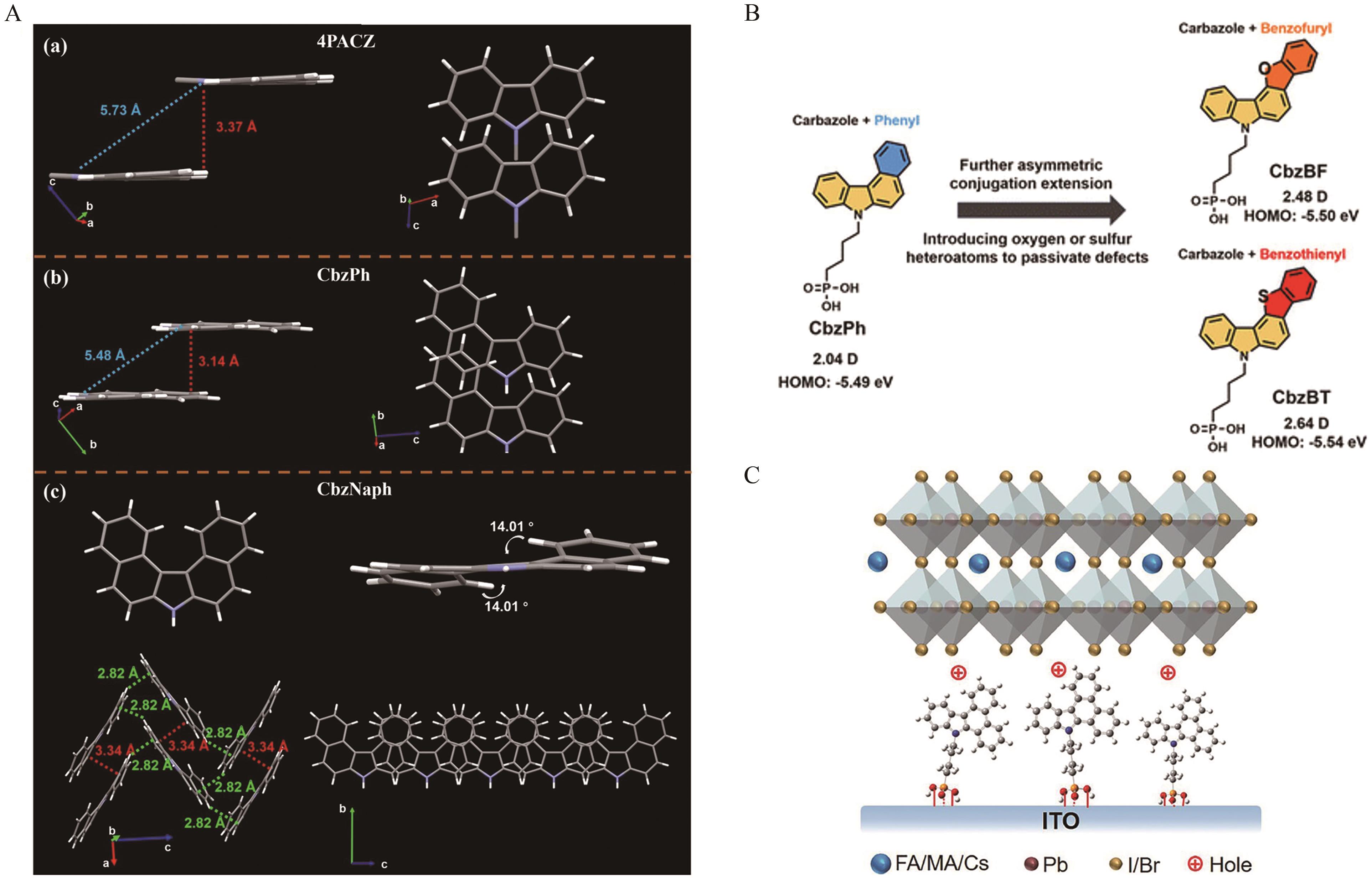
图4 (A)单晶中π-骨架的分子堆积模式,分别对应: (a) 4PACz(原始咔唑)、(b) CbzPh(7H-苯并[c]咔唑)和(c) CbzNaph(7H-二苯并[c,g]咔唑)。 二面角是通过中央吡咯环和平面外苯环定义的平面进行测量的[54]; (B) CbzPh、CbzBF和CbzBT的分子结构、计算的偶极矩和HOMO能级[55]; (C)以A-4PADCB作为ITO与钙钛矿之间HSL的示意图[56]
Fig.4 (A)Molecular packing patterns of π-backbones in single crystals, corresponding to: (a) 4PACz (pristine carbazole), (b) CbzPh (7H-benzo[c]carbazole), and (c) CbzNaph (7H-dibenzo[c,g]carbazole). The dihedral angles were measured through the plane defined by the central pyrrole ring and the outermost benzene ring[54]; (B) Molecular structures, calculated dipole moments and HOMO energy levels of CbzPh, CbzBF and CbzBT[55]; (C) Schematic representation of A-4PADCB as the hole-selective layer (HSL) between ITO and perovskite[56]

图5 (A)不同空穴传输层(HTL)与钙钛矿之间的能级示意图[39]; (B)参考真空能级,不同HTL接触层与CsMAFA钙钛矿之间的能级排列,其中红色虚线表示通过UPS测量得到的费米能级位置[52]
Fig.5 (A) Energy level diagram between different hole transport layers (HTL) and the perovskite[39]; (B) Energetic alignment of different HTL contacts and CsMAFA perovskite with reference to the vacuum level, where the red dashed lines represent the Fermi energy levels measured by UPS[52]
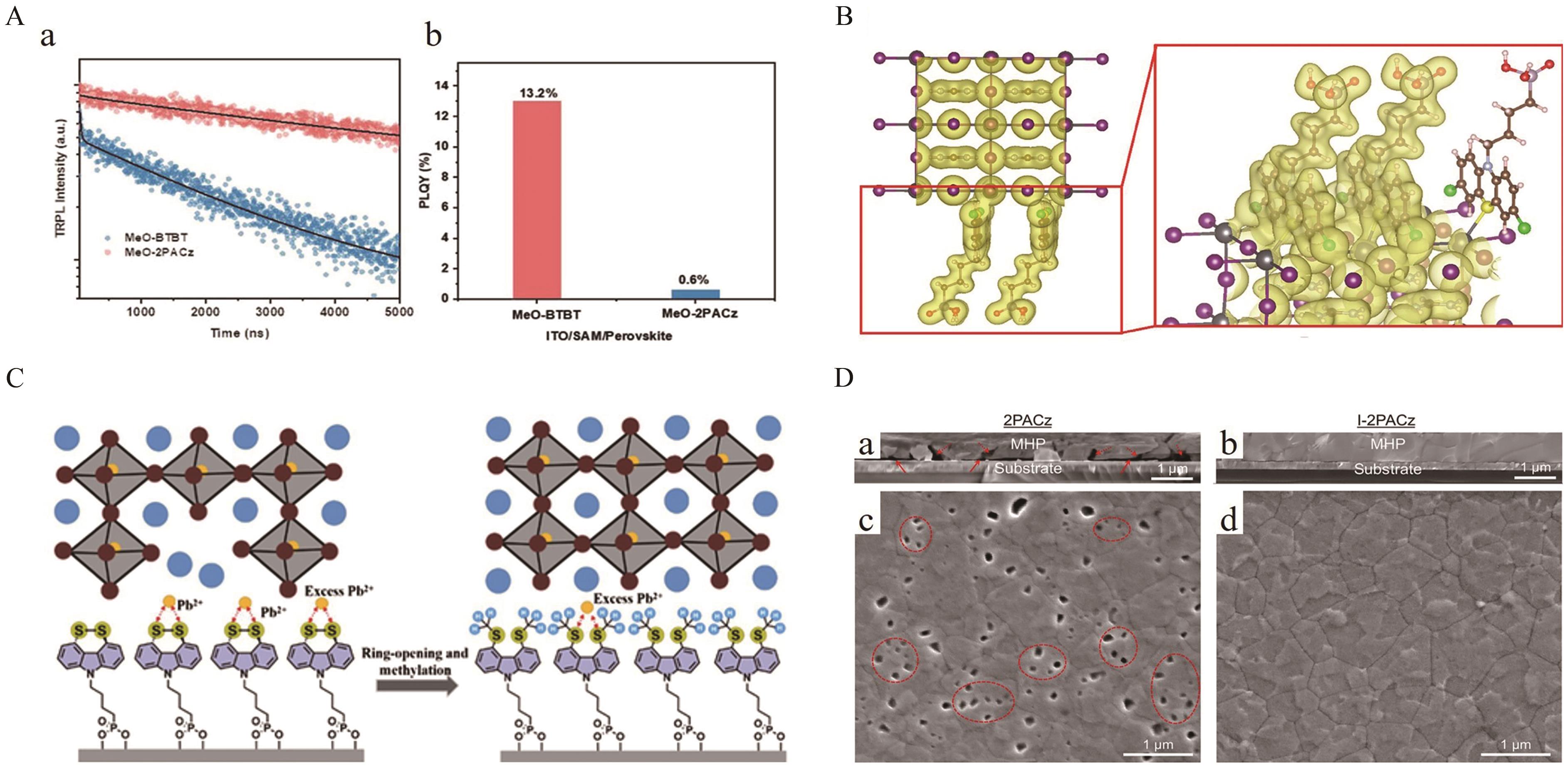
图6 (A)钙钛矿薄膜的表征:(a)时间分辨光致发光谱图,(b)光致发光量子产率[58]; (B) DFT计算得到的TDPA-Cl和钙钛矿的界面轨道分布。 插图显示了TDPA-Cl和钙钛矿之间的轨道重叠[59]; (C) Cbz2S和Cbz2SMe为HSL与钙钛矿相互作用示意图[60]; (D)含有SAMs的经1000 h测试的iPSCs的横断面SEM图像: (a) 2PACz和(b) I-2PACz,(a)中的虚线和实线箭头分别标出了孔隙和分层。 具有SAMs的iPSCs在MHP侧的断裂面SEM图像: (c) 2PACz和(d)I-2PACz。 (c)中的虚线椭圆标记了一些晶粒内的微孔隙示例[42]
Fig.6 (A) Characterization of perovskite films: (a) Time-resolved photoluminescence spectra, (b) photoluminescence quantum yield [58]; (B) Interfacial orbital distribution of TDPA-Cl and perovskite from the DFT calculation. The inset shows the orbital overlap between TDPA-Cl and perovskite[59]; (C) Schematic illustration of interaction of Cbz2S and Cbz2SMe as HSLs with the perovskite[60]; (D) Cross-sectional SEM images of 1000-h-tested iPSCs with SAMs: (a) 2PACz and (b) I-2PACz, dashed and solid arrows in (a) mark pores and delamination, respectively. SEM images of fracture surfaces (MHP side) of 1000-h-tested iPSCs with SAMs: (c) 2PACz and (d) I-2PACz. Dashed ovals in (c) mark some examples of in-grain microscopic pores[42]
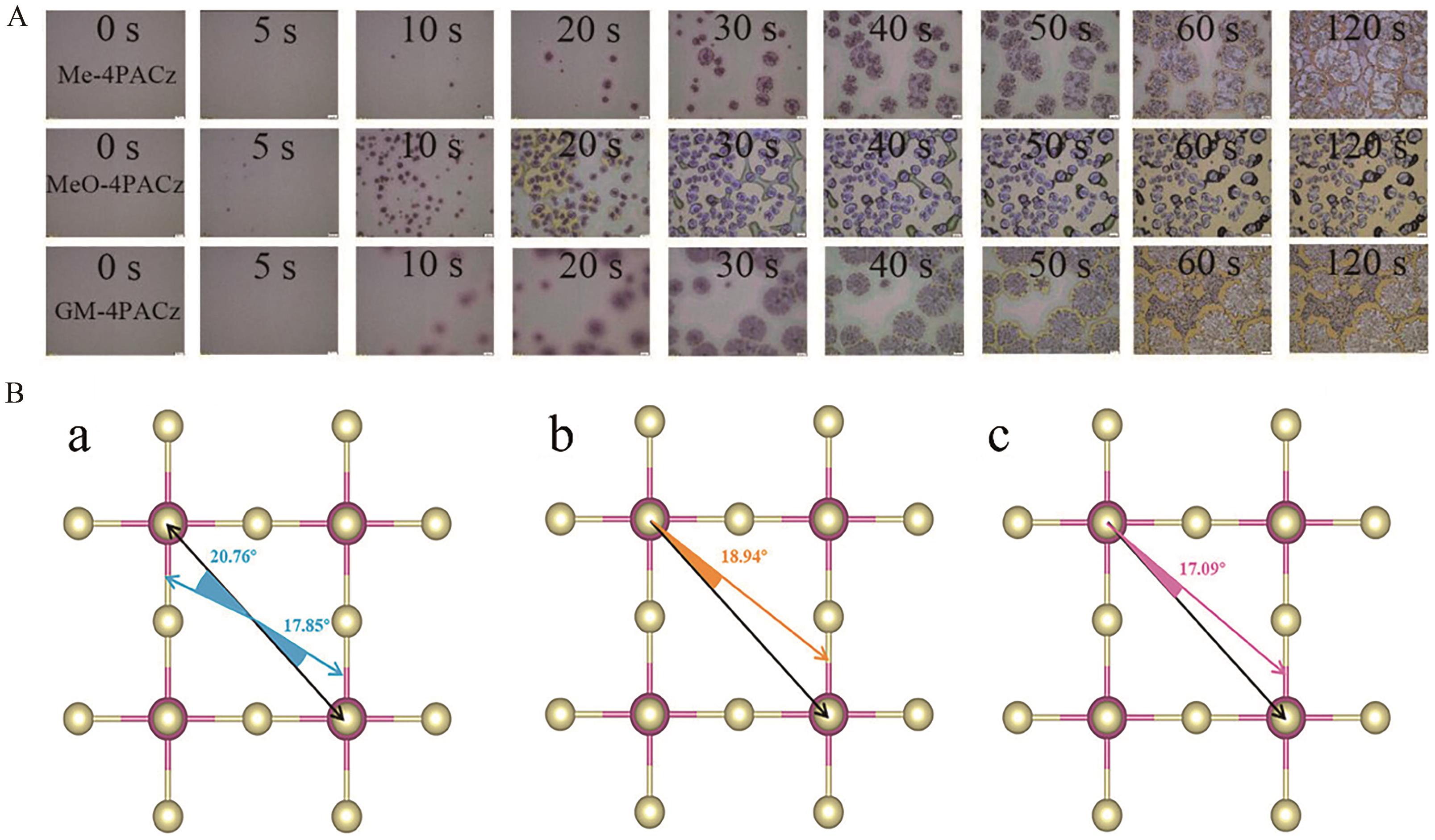
图7 (A)经不同时间退火后Me-/MeO-/GM-4PACz基底上的前驱体钙钛矿薄膜的照片[61]; (B) (a) 2PACz/I原子、(b) 9CPA/I原子和(c) 9CAA/I原子的偏角[62]
Fig.7 (A) Photographs of the precursor perovskite films on Me-/MeO-/GM-4PACz substrates after annealing for different times [61]; (B) The deviation angles of (a) 2PACz/I atom, (b) 9CPA/I atom and (c) 9CAA/I atom[62]

图8 (A) FAPbI?钙钛矿薄膜在MeO-2PACz和PTZ-CPA基底上旋涂过程中的原位PL光谱[64]; (B) FTO/Me-4PACz/钙钛矿和FTO/Ph-4PACz/钙钛矿能级图[65]; (C)在365 nm紫外光照射24 h后的C1s区域的XPS光谱[66]
Fig.8 (A) (a) In situ PL spectra for FAPbI3 perovskite films deposited on MeO-2PACz and PTZ-CPA during the spin-coating process[64]; (B) Energy level diagrams of FTO/Me-4PACz/perovskite and FTO/Ph-4PACz/perovskite[65]; (C) X-ray photoelectron spectroscopy (XPS) of the C1s region with 365 nm UV light irradiation for 24 h[66]
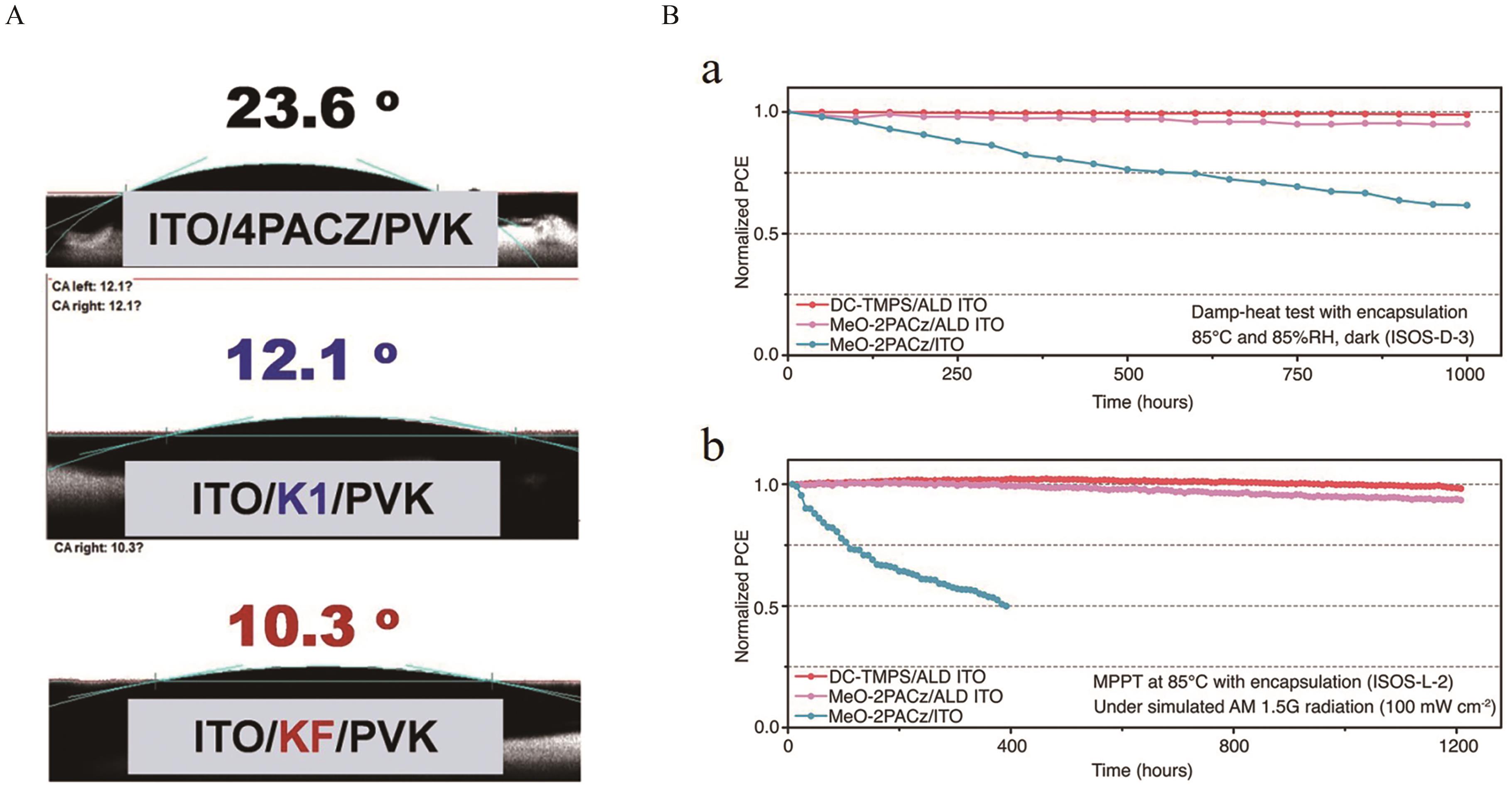
图9 (A) SAMs修饰基底上钙钛矿前驱体液滴的接触角[68]; (B) iPSCs的长期稳定性研究: (a)最稳定的封装iPSCs在潮湿高温条件下的稳定性,使用了带MeO-2PACz的ITO和ALD ITO与DC-TMPS及MeO-2PACz; (b)最大功率点(MPP)追踪测试结果: 最稳定的封装iPSCs在85 ℃下,在模拟AM1.5 G光照(100 mW/cm2)条件下,使用了带MeO-2PACz的ITO和ALD ITO与DC-TMPS及MeO-2PACz[69]
Fig.9 (A) Contact angles with respect to perovskite precursor droplets on SAMs-modified substrates[68]; (B) Long-term stability studies of the iPSCs: (a) Damp-heat stability for the most-stable encapsulated iPSCs using ITO with MeO-2PACz and ALD ITO with DC-TMPS and MeO-2PACz; (b) MPP of the most-stable encapsulated iPSCs measured at 85 ℃ using ITO with MeO-2PACz and ALD ITO with DC-TMPS and MeO-2PACz under simulated AM1.5 G illumination (100 mW/cm2)[69]
| Molecular name | HOMO/eV | Device structure | Perovskite bandgap/eV | VOC/V | JSC/(mA·cm-2) | FF/% | PCE/% | Ref. |
|---|---|---|---|---|---|---|---|---|
| Me-4PACz | -5.80 | ITO/2PACz/Perovskite/C60/BCP/Cu(Ag) | 1.68 | 1.220 | 20.70 | 82.00 | 20.80 | [ |
2-T: Ag/AZO/a-Si(p)/a-Si(i)/c-Si(n)/a-Si(i)/nc-SiO x (n)/ITO/Me-4PACz/ Perovskite/LiF/C60/SnO2/IZO/Ag/LiF | Top cell: 1.68 Bottom cell: Si | 1.900 | 9.26 | 79.52 | 29.15 | |||
| 2PACz | -5.60 | ITO/2PACz/Perovskite/C60/BCP/Cu(Ag) | 1.60 | 1.188 | 21.90 | 80.20 | 20.80 | [ |
| MeO-2PACz | -5.10 | ITO/MeO-2PACz/Perovskite/C60/BCP/Cu(Ag) | 1.63 | 1.144 | 22.20 | 80.50 | 20.20 | |
| MeO-4PADCB | -5.34 | ITO/NiO x /MeO-4PADCB/Perovskite/CF3-PEAI+MAI/C60/BCP/Ag | 1.53 | 1.190 | 25.40 | 84.60 | 25.60 | [ |
| I-2PACz | -5.98 | ITO/I-2PACz/Perovskite/C60/BCP/Ag | 1.55 | 1.163 | 25.43 | 85.80 | 25.39 | [ |
| Br-2EPT | -5.47 | TCO/Br-2EPT/Perovskite/C60/BCP/Cu | 1.56 | 1.090 | 25.11 | 82.00 | 22.44 | [ |
| CbzPh | -5.36 | ITO/CbzPh/Perovskite/PI/C60/BCP/Ag | 1.56 | 1.120 | 23.43 | 73.06 | 19.20 | [ |
| CbzNaPh | -5.35 | ITO/CbzNaph/Perovskite/PI/C60/BCP/Ag | 1.170 | 24.69 | 83.39 | 24.10 | ||
| CbzBF | -5.50 | ITO/CbzBF/Perovskite/PI/C60/BCP/Ag | 1.56 | 1.090 | 24.00 | 83.04 | 21.72 | [ |
| CbzBT | -5.54 | ITO/CbzBT/Perovskite/PI/C60/BCP/Ag | 1.161 | 24.54 | 84.41 | 24.04 | ||
| A-4PADCB | -5.23 | ITO/A-4PADCB/Perovskite/C60/BCP/Ag | 1.55 | 1.186 | 25.39 | 83.14 | 25.05 | [ |
| DCB-BPA | -5.56 | ITO/DCB-BPA/Perovskite/C60/BCP/Cu | 1.77 | 1.330 | 17.75 | 82.70 | 19.53 | [ |
4-T: ITO/DCB-BPA/Perovskite/C60/SnO2/IZO/ transparent electrode/glass/ ITO/PEDOT:PSS/Perovskite/C60/BCP/Cu | Top cell: 1.77 Bottom cell: 1.25 | - | - | - | 26.90 | |||
| MeO-BTBT | -5.28 | ITO/MeO-BTBT/Perovskite/PI/C60/BCP/Ag | 1.56 | 1.160 | 24.87 | 85.28 | 24.53 | [ |
| TDPA-Cl | -5.42 | ITO/TDPA-Cl/Perovskite/C60/BCP/Ag | 1.55 | 1.151 | 23.90 | 81.40 | 22.40 | [ |
| Cbz2S | -5.45 | ITO/Cbz2S/Perovskite/PI/C60/BCP/Ag | 1.55 | 0.997 | 24.15 | 80.20 | 19.23 | [ |
| Cbz2SMe | -5.37 | ITO/Cbz2SMe/Perovskite/PI/C60/BCP/Ag | 1.55 | 1.172 | 25.16 | 82.82 | 24.42 | |
| GM-4PACz | -5.32 | ITO/GM-4PACz/Perovskite/PC61BM/BCP/Ag | 1.58 | 1.210 | 25.43 | 82.75 | 25.52 | [ |
| 9CPA | -5.19 | FTO/9CPA/Perovskite/C60/BCP/Ag | 1.25 | 0.890 | 32.50 | 76.00 | 22.10 | [ |
| 9CAA | -5.35 | FTO/9CAA/Perovskite/C60/BCP/Ag | 0.890 | 32.80 | 79.00 | 23.10 | ||
| 4dp3PACz | -5.77 | ITO/4dp3PACz/Perovskite/GuBr/C60/BCP/Ag | 1.77 | 1.214 | 17.80 | 79.44 | 17.17 | [ |
| PTZ-CPA | -5.40 | ITO/PTZ-CPA/Perovskite/F-PEAI/C60/BCP/Ag | 1.54 | 1.180 | 25.58 | 83.98 | 25.35 | [ |
| Ph-4PACz | -5.21 | FTO/Al2O3-NPs/Ph-4PACz/Perovskite /PDI/PCBM/BCP/Ag | 1.55 | 1.207 | 25.18 | 84.23 | 25.60 | [ |
| MeO-PhPACz | -5.61 | ITO/MeO-PhPACz/Perovskite/C60/BCP/Ag | 1.68 | 1.215 | 20.59 | 84.28 | 21.10 | [ |
| C-2PACz | -5.46 | ITO/C-2PACz/Perovskite/C60/BCP/Ag | 1.56 | 1.050 | 22.45 | 77.37 | 18.16 | [ |
| S-2PACz | -5.48 | ITO/S-2PACz/Perovskite/C60/BCP/Ag | 1.050 | 22.70 | 78.65 | 18.65 | ||
| K1 | -5.47 | ITO/K1/Perovskite/C60/BCP/Ag | - | 1.172 | 25.17 | 83.62 | 24.66 | [ |
| KF | -5.49 | ITO/KF/Perovskite/C60/BCP/Ag | 1.187 | 25.27 | 83.37 | 25.02 | ||
| DC-TMPS | -5.23 | ITO/ALD ITO/DC-TMPS/Perovskite /PEAI/C60/ZnO/Au | 1.55 | 1.180 | 25.10 | 84.10 | 24.80 | [ |
| Py3 | -5.47 | ITO/Py3/Perovskite/LiF/C60/BCP/Ag | - | 1.180 | 26.00 | 85.10 | 26.10 | [ |
表1 用于HSL的SAMs分子和相应的器件参数
Table 1 SAMs molecules used for HSL and corresponding device parameters
| Molecular name | HOMO/eV | Device structure | Perovskite bandgap/eV | VOC/V | JSC/(mA·cm-2) | FF/% | PCE/% | Ref. |
|---|---|---|---|---|---|---|---|---|
| Me-4PACz | -5.80 | ITO/2PACz/Perovskite/C60/BCP/Cu(Ag) | 1.68 | 1.220 | 20.70 | 82.00 | 20.80 | [ |
2-T: Ag/AZO/a-Si(p)/a-Si(i)/c-Si(n)/a-Si(i)/nc-SiO x (n)/ITO/Me-4PACz/ Perovskite/LiF/C60/SnO2/IZO/Ag/LiF | Top cell: 1.68 Bottom cell: Si | 1.900 | 9.26 | 79.52 | 29.15 | |||
| 2PACz | -5.60 | ITO/2PACz/Perovskite/C60/BCP/Cu(Ag) | 1.60 | 1.188 | 21.90 | 80.20 | 20.80 | [ |
| MeO-2PACz | -5.10 | ITO/MeO-2PACz/Perovskite/C60/BCP/Cu(Ag) | 1.63 | 1.144 | 22.20 | 80.50 | 20.20 | |
| MeO-4PADCB | -5.34 | ITO/NiO x /MeO-4PADCB/Perovskite/CF3-PEAI+MAI/C60/BCP/Ag | 1.53 | 1.190 | 25.40 | 84.60 | 25.60 | [ |
| I-2PACz | -5.98 | ITO/I-2PACz/Perovskite/C60/BCP/Ag | 1.55 | 1.163 | 25.43 | 85.80 | 25.39 | [ |
| Br-2EPT | -5.47 | TCO/Br-2EPT/Perovskite/C60/BCP/Cu | 1.56 | 1.090 | 25.11 | 82.00 | 22.44 | [ |
| CbzPh | -5.36 | ITO/CbzPh/Perovskite/PI/C60/BCP/Ag | 1.56 | 1.120 | 23.43 | 73.06 | 19.20 | [ |
| CbzNaPh | -5.35 | ITO/CbzNaph/Perovskite/PI/C60/BCP/Ag | 1.170 | 24.69 | 83.39 | 24.10 | ||
| CbzBF | -5.50 | ITO/CbzBF/Perovskite/PI/C60/BCP/Ag | 1.56 | 1.090 | 24.00 | 83.04 | 21.72 | [ |
| CbzBT | -5.54 | ITO/CbzBT/Perovskite/PI/C60/BCP/Ag | 1.161 | 24.54 | 84.41 | 24.04 | ||
| A-4PADCB | -5.23 | ITO/A-4PADCB/Perovskite/C60/BCP/Ag | 1.55 | 1.186 | 25.39 | 83.14 | 25.05 | [ |
| DCB-BPA | -5.56 | ITO/DCB-BPA/Perovskite/C60/BCP/Cu | 1.77 | 1.330 | 17.75 | 82.70 | 19.53 | [ |
4-T: ITO/DCB-BPA/Perovskite/C60/SnO2/IZO/ transparent electrode/glass/ ITO/PEDOT:PSS/Perovskite/C60/BCP/Cu | Top cell: 1.77 Bottom cell: 1.25 | - | - | - | 26.90 | |||
| MeO-BTBT | -5.28 | ITO/MeO-BTBT/Perovskite/PI/C60/BCP/Ag | 1.56 | 1.160 | 24.87 | 85.28 | 24.53 | [ |
| TDPA-Cl | -5.42 | ITO/TDPA-Cl/Perovskite/C60/BCP/Ag | 1.55 | 1.151 | 23.90 | 81.40 | 22.40 | [ |
| Cbz2S | -5.45 | ITO/Cbz2S/Perovskite/PI/C60/BCP/Ag | 1.55 | 0.997 | 24.15 | 80.20 | 19.23 | [ |
| Cbz2SMe | -5.37 | ITO/Cbz2SMe/Perovskite/PI/C60/BCP/Ag | 1.55 | 1.172 | 25.16 | 82.82 | 24.42 | |
| GM-4PACz | -5.32 | ITO/GM-4PACz/Perovskite/PC61BM/BCP/Ag | 1.58 | 1.210 | 25.43 | 82.75 | 25.52 | [ |
| 9CPA | -5.19 | FTO/9CPA/Perovskite/C60/BCP/Ag | 1.25 | 0.890 | 32.50 | 76.00 | 22.10 | [ |
| 9CAA | -5.35 | FTO/9CAA/Perovskite/C60/BCP/Ag | 0.890 | 32.80 | 79.00 | 23.10 | ||
| 4dp3PACz | -5.77 | ITO/4dp3PACz/Perovskite/GuBr/C60/BCP/Ag | 1.77 | 1.214 | 17.80 | 79.44 | 17.17 | [ |
| PTZ-CPA | -5.40 | ITO/PTZ-CPA/Perovskite/F-PEAI/C60/BCP/Ag | 1.54 | 1.180 | 25.58 | 83.98 | 25.35 | [ |
| Ph-4PACz | -5.21 | FTO/Al2O3-NPs/Ph-4PACz/Perovskite /PDI/PCBM/BCP/Ag | 1.55 | 1.207 | 25.18 | 84.23 | 25.60 | [ |
| MeO-PhPACz | -5.61 | ITO/MeO-PhPACz/Perovskite/C60/BCP/Ag | 1.68 | 1.215 | 20.59 | 84.28 | 21.10 | [ |
| C-2PACz | -5.46 | ITO/C-2PACz/Perovskite/C60/BCP/Ag | 1.56 | 1.050 | 22.45 | 77.37 | 18.16 | [ |
| S-2PACz | -5.48 | ITO/S-2PACz/Perovskite/C60/BCP/Ag | 1.050 | 22.70 | 78.65 | 18.65 | ||
| K1 | -5.47 | ITO/K1/Perovskite/C60/BCP/Ag | - | 1.172 | 25.17 | 83.62 | 24.66 | [ |
| KF | -5.49 | ITO/KF/Perovskite/C60/BCP/Ag | 1.187 | 25.27 | 83.37 | 25.02 | ||
| DC-TMPS | -5.23 | ITO/ALD ITO/DC-TMPS/Perovskite /PEAI/C60/ZnO/Au | 1.55 | 1.180 | 25.10 | 84.10 | 24.80 | [ |
| Py3 | -5.47 | ITO/Py3/Perovskite/LiF/C60/BCP/Ag | - | 1.180 | 26.00 | 85.10 | 26.10 | [ |
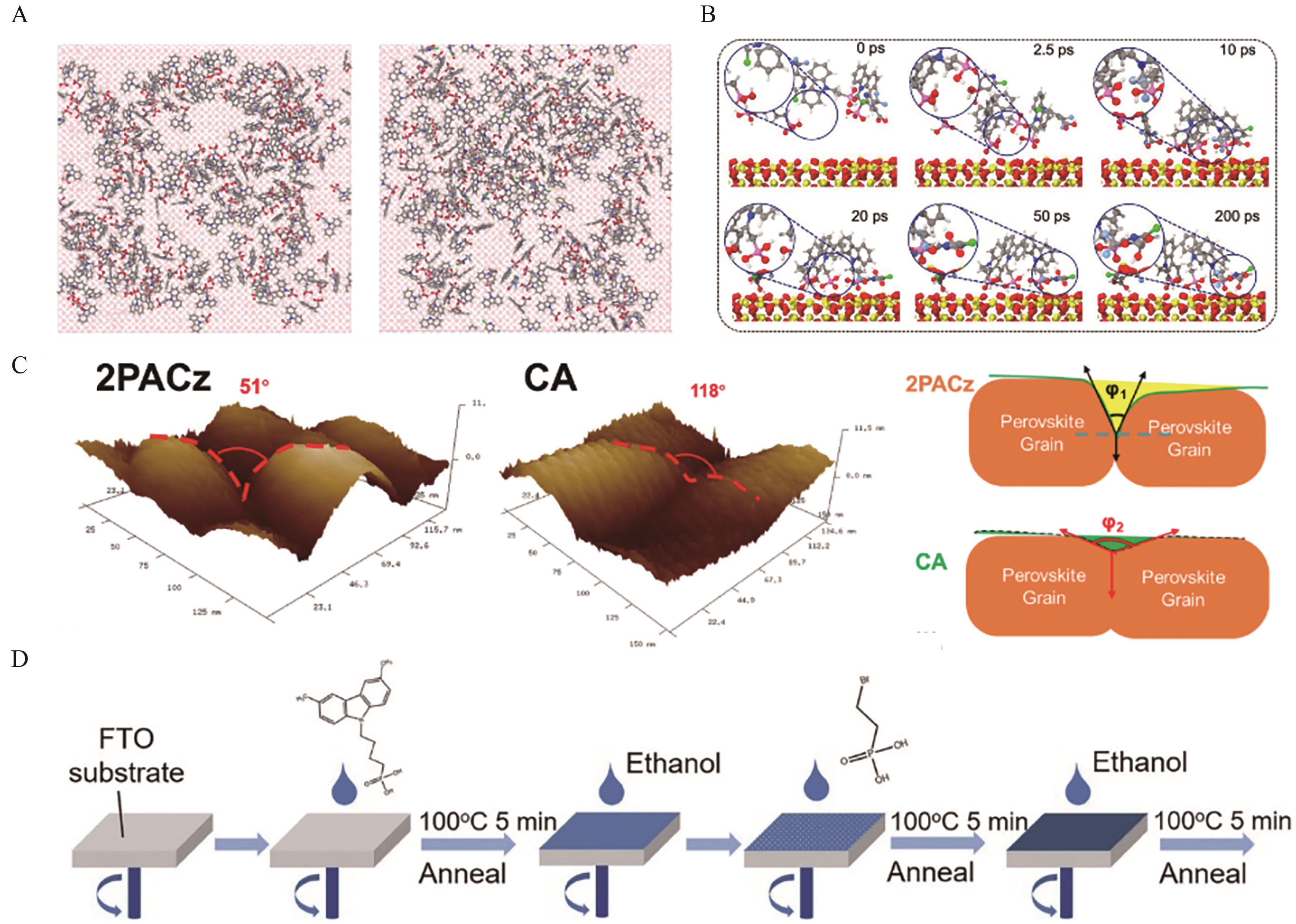
图10 (A)对照和混合系统的分子模型俯视图; (B )AIMD轨迹中连续的步骤展示了2种分子之间的相互作用。小圆圈内的界面结构在大圆圈区域中被放大显示; (C) 2PACz和CA基钙钛矿薄膜底界面的高分辨率原子力显微镜(AFM)图像和相应的模型[71]; (D)顺序沉积过程示意图[48]
Fig.10 (A) Top views of equilibrated molecular representations of control and mixed systems; (B) Successive steps along an AIMD trajectory showcasing the interactions between the two molecules. The interfacial structures within small circles are magnified in larger circle areas; (C) High-resolution atomic force microscope (AFM) images of the buried interfaces of 2PACz- and CA-based perovskite thin films, along with corresponding models[71]; (D) Schematic diagram of the sequential deposition process[48]
| Molecular name | HOMO/eV | Device structure | Perovskite bandgap/eV | VOC/V | JSC/(mA·cm-2) | FF/% | PCE/% | Ref. | |
|---|---|---|---|---|---|---|---|---|---|
| 2PACz | PyCA-3F | -5.50 | ITO/2-PACz/PyCA-3F/Perovskite/ C60/BCP/Cu | 1.53 | 1.170 | 25.22 | 86 | 25.12 | [ |
| Me-4PACz | -5.80 | 2-T: ITO/2PACz/Me-2PACz/Perovskite/ ALD SnO x /Au/PEDOT:PSS /Perovskite/C60/BCP/Cu | top cell: 1.78 bottom cell: - | 2.150 | 15.81 | 80.49 | 27.34 | [ | |
4-T: ITO/2PACz/Me-2PACz/Perovskite/ ALD-SnO x /ITO/Glass/ITO/ PEDOT:PSS/Perovskite/C60/BCP/Cu | top cell: 1.78 bottom cell: - | - | - | - | 28.05 | ||||
| Me-4PACz | EPA | - | FTO/Me-4PACz/EPA/Perovskite/ PCBM/BCP/Ag | 1.56 | 1.150 | 24.32 | 80.32 | 22.48 | [ |
| Br-EPA | - | FTO/Me-4PACz/Br-EPA/Perovskite/PCBM/BCP/Ag | 1.200 | 25.10 | 83.54 | 25.16 | |||
表2 顺序沉积策略作为HSL的性能参数
Table 2 Performance parameters of sequential deposition strategy as HSL
| Molecular name | HOMO/eV | Device structure | Perovskite bandgap/eV | VOC/V | JSC/(mA·cm-2) | FF/% | PCE/% | Ref. | |
|---|---|---|---|---|---|---|---|---|---|
| 2PACz | PyCA-3F | -5.50 | ITO/2-PACz/PyCA-3F/Perovskite/ C60/BCP/Cu | 1.53 | 1.170 | 25.22 | 86 | 25.12 | [ |
| Me-4PACz | -5.80 | 2-T: ITO/2PACz/Me-2PACz/Perovskite/ ALD SnO x /Au/PEDOT:PSS /Perovskite/C60/BCP/Cu | top cell: 1.78 bottom cell: - | 2.150 | 15.81 | 80.49 | 27.34 | [ | |
4-T: ITO/2PACz/Me-2PACz/Perovskite/ ALD-SnO x /ITO/Glass/ITO/ PEDOT:PSS/Perovskite/C60/BCP/Cu | top cell: 1.78 bottom cell: - | - | - | - | 28.05 | ||||
| Me-4PACz | EPA | - | FTO/Me-4PACz/EPA/Perovskite/ PCBM/BCP/Ag | 1.56 | 1.150 | 24.32 | 80.32 | 22.48 | [ |
| Br-EPA | - | FTO/Me-4PACz/Br-EPA/Perovskite/PCBM/BCP/Ag | 1.200 | 25.10 | 83.54 | 25.16 | |||

图11 (A)单一SAMs和(B)Co-SAMs的KPFM表面电位图[75]; (C)钙钛矿/硅串联太阳能电池(P/S-TSCs)的示意图; (D)最佳P/S-TSCs在正向和反向扫描方向下的电流-电压(J-V)特性曲线。 插图展示了P/S-TSCs的照片[78]
Fig.11 KPFM surface potential images of (A) single-SAMs and (B) Co-SAMs[75]; (C) A schematic illustration of the perovskite/silicon tandem solar cells(P/S-TSCs); (D) Along with the J-V curves measured under forward and reverse scanning directions for the champion P/S-TSCs. The inset features a photograph of the P/S-TSCs[78]
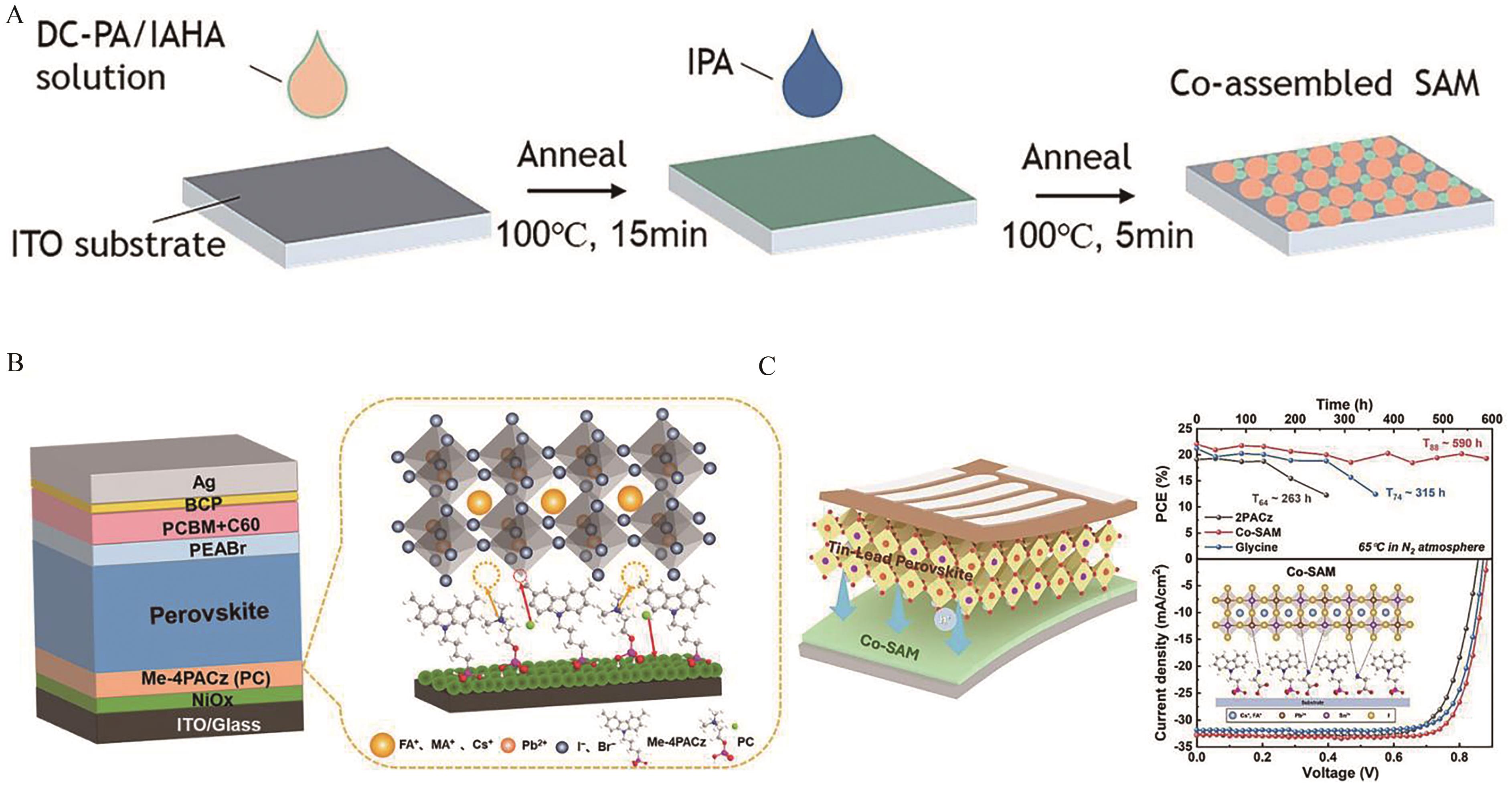
图12 (A) Co-SAMs单层制造示意图[79]; (B)反式器件结构以及Co-SAMs与NiO x 和钙钛矿薄膜的相互作用的示意图[46]; (C)涂覆在ITO/2PACz 和ITO/Co-SAMs 上的Sn-Pb钙钛矿薄膜的晶格结构示意图及稳定性测试[47]
Fig.12 (A) Schematic diagram of the fabrication of Co-SAMs monolayers[79]; (B) Schematic diagram of the inverted device structure and the interaction of Co-SAMs with NiO x and perovskite films[46]; (C) Schematic diagram of the lattice structure and stability tests of Sn-Pb perovskite films coated on ITO/2PACz and ITO/Co-SAMs[47]
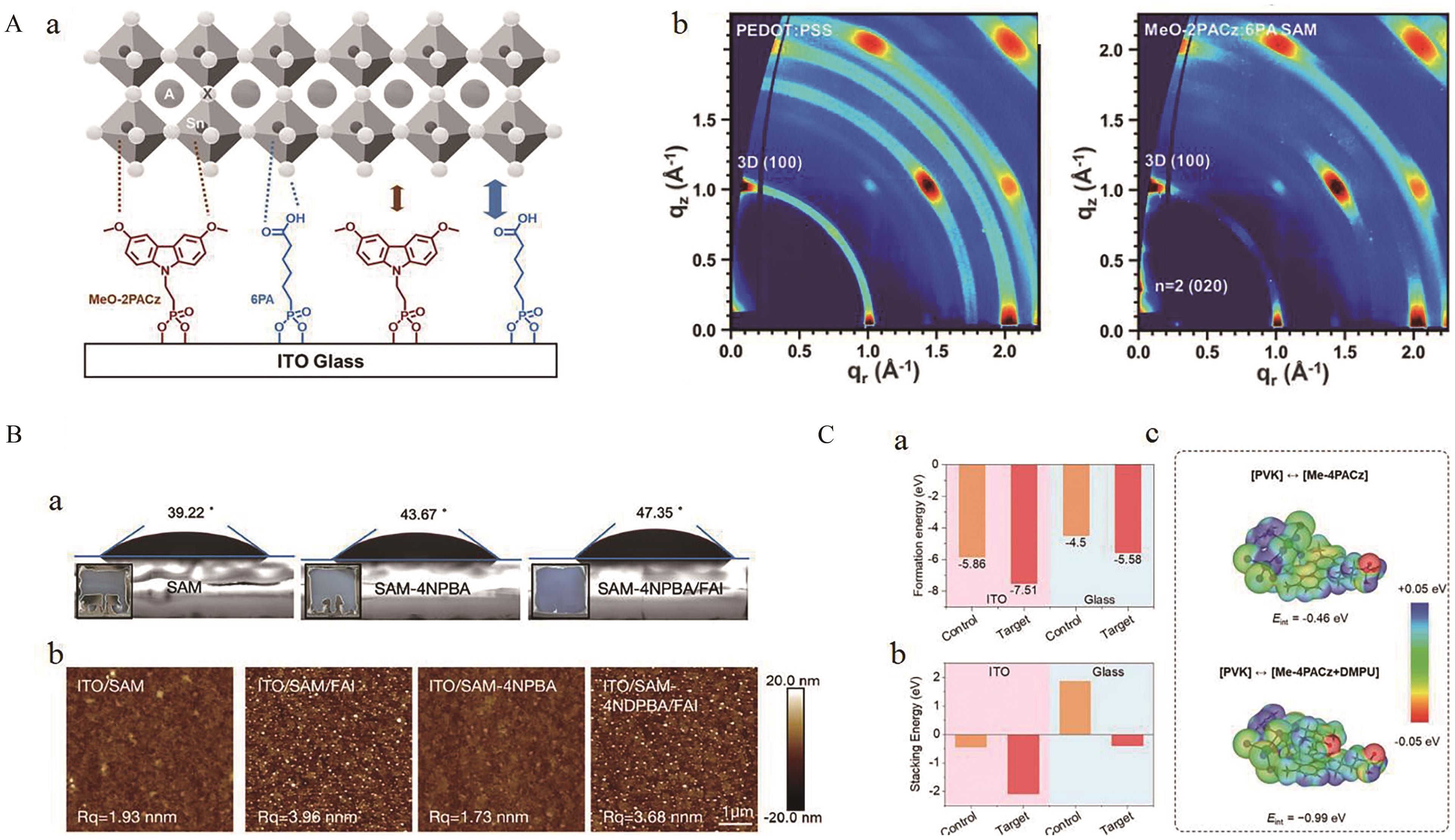
图13 (A) (a)锡基钙钛矿与MeO-2PACz和6PA相互作用的示意图; (b)锡基钙钛矿薄膜在PEDOT:PSS和Co-SAMs基底上的GIWAXS图像(入射角0.20(°))[80]; (B) (a)钙钛矿前驱体溶液在ITO/SAM、ITO/SAM-4NPBA和SAM-4NPBA/FAI基底上的接触角测试及旋涂后薄膜的光学图像; (b) ITO/SAM、ITO/SAM/FAI、ITO/SAM-4NPBA和SAM-4NPBA/FAI基底的AFM表面形貌图[81]; (C) (a)基于DFT的Me-4PACz在ITO和玻璃上的界面形成能(是否添加DMPU); (b) Me-4PACz在ITO和玻璃上的堆叠能; (c)钙钛矿与Me-4PACz以及Me-4PACz+DMPU的静电势分布和相互作用能分析[82]
Fig.13 (A) (a) Schematic illustration of the interaction between tin perovskite and MeO-2PACz and 6PA; (b) GIWAXS images of tin perovskite films on PEDOT:PSS and Co-SAMs substrates at an incidence angle of 0.20 (°)[80]; (B) (a) Contact angle tests of perovskite precursor solutions on ITO/SAM, ITO/SAM-4NPBA, and SAM-4NPBA/FAI substrates, with corresponding images of perovskite films after spin-coating shown below; (b) AFM topography images of ITO/SAM, ITO/SAM/FAI, ITO/SAM-4NPBA, and SAM-4NPBA/FAI substrates[81]; (C) (a) DFT calculations of Me-4PACz with and without DMPU additive strategy on ITO and glass. Interface formation energy of Me-4PACz on glass/ITO surfaces; (b) Stacking energy of Me-4PACz on glass/ITO surfaces; (c) Electrostatic potential (ESP) distribution and interaction energy between perovskite and Me-4PACz, perovskite and Me-4PACz+DMPU[82]
| Molecular name | HOMO/ eV | Device structure | Perovskite bandgap/eV | VOC/V | JSC/(mA·cm-2) | FF/% | PCE/% | Ref. | |
|---|---|---|---|---|---|---|---|---|---|
| 2PACz | 3-MPA | -5.64 | FTO/2-PACz(3-MPA)/Perovskite/C60/BCP/Ag | 1.54 | 1.160 | 25.90 | 84.2 | 25.3 | [ |
| Glycine | -5.87 | ITO/2-PACz(Glycine)/Perovskite/EDAI2/PCBM/C60/BCP/Ag | 1.26 | 0.880 | 32.85 | 80.8 | 23.46 | [ | |
| Me-4PACz | BA | -5.61 | ITO/Me-4PACz(BA)/Perovskite/PI/PCBM/BCP/Ag | 1.53 | 1.168 | 25.90 | 81.48 | 24.65 | [ |
| NA | -5.68 | ITO/Me-4PACz(NA)/Perovskite/PI/PCBM/BCP/Ag | 1.201 | 26.30 | 84.50 | 26.69 | |||
| TA | -5.65 | ITO/Me-4PACz(TA)/Perovskite/PI/PCBM/BCP/Ag | 1.179 | 26.10 | 82.84 | 25.49 | |||
| PC | -5.43 | ITO/NiO x /Me-4PACz(PC)/Perovskite/PEABr/PCBM/C60/BCP/Ag | 1.55 | 1.175 | 25.88 | 82.54 | 25.09 | [ | |
| MeO-PhPACz | -5.62 | 2-T: Ag/ITO/a-Si:H(p)/a-Si:H(i)/n-type Cz-Si/a-Si:H(i)/a-Si:H(n)/ITO/Me-4PACz:MeO-PhPACz/Perovskite/C60/ALD SnO2/IZO/Ag/MgF2 | top cell: 1.68 bottom cell: Si | 1.893 | 18.54 | 79.97 | 28.07 | [ | |
| DMPU | -5.51 | ITO/Me-4PACz(DMPU)/Perovskite/C60/BCP/Ag | 1.67 | 1.230 | 21.40 | 85.00 | 22.40 | [ | |
| MeO-2PACz | MPA | — | ITO/NiO x /MeO-2PACz(MPA)/Al2O3/Perovskite/PEAI/PCBM/BCP/Ag | 1.60 | 1.216 | 23.87 | 81.50 | 23.68 | [ |
| 6PA | — | ITO/MeO-2PACz(6PA)/Perovskite /ICBA/BCP/Ag | 1.40 | 0.829 | 17.60 | 64.50 | 9.40 | [ | |
| DC-PA | IAHA | -5.37 | ITO/DC-PA(IAHA)/Perovskite/C60/BCP/Ag | 1.49 | 1.160 | 24.66 | 82.45 | 23.59 | [ |
| DMACPA | 4-NPBA | -5.47 | ITO/DMACPA(4-NPBA)/FAI/Perovskite/C60/BCP/Ag | 1.54 | 1.180 | 24.18 | 88.35 | 25.29 | [ |
| MeO-2PACz | 2-PACz | -5.9 | PET/ITO/MB-NiO x /Perovskite/C60/ALD-SnO2/Au/PEDOT:PSS/Perovskite/C60/BCP/Cu | top cell: 1.75 bottom cell:1.22 | 2.000 | 15.80 | 78.30 | 24.70 | [ |
表3 Co-SAMs策略作为HSL的性能参数
Table 3 Performance parameters of Co-assembled monolayers Co-SAMs strategy as HSL
| Molecular name | HOMO/ eV | Device structure | Perovskite bandgap/eV | VOC/V | JSC/(mA·cm-2) | FF/% | PCE/% | Ref. | |
|---|---|---|---|---|---|---|---|---|---|
| 2PACz | 3-MPA | -5.64 | FTO/2-PACz(3-MPA)/Perovskite/C60/BCP/Ag | 1.54 | 1.160 | 25.90 | 84.2 | 25.3 | [ |
| Glycine | -5.87 | ITO/2-PACz(Glycine)/Perovskite/EDAI2/PCBM/C60/BCP/Ag | 1.26 | 0.880 | 32.85 | 80.8 | 23.46 | [ | |
| Me-4PACz | BA | -5.61 | ITO/Me-4PACz(BA)/Perovskite/PI/PCBM/BCP/Ag | 1.53 | 1.168 | 25.90 | 81.48 | 24.65 | [ |
| NA | -5.68 | ITO/Me-4PACz(NA)/Perovskite/PI/PCBM/BCP/Ag | 1.201 | 26.30 | 84.50 | 26.69 | |||
| TA | -5.65 | ITO/Me-4PACz(TA)/Perovskite/PI/PCBM/BCP/Ag | 1.179 | 26.10 | 82.84 | 25.49 | |||
| PC | -5.43 | ITO/NiO x /Me-4PACz(PC)/Perovskite/PEABr/PCBM/C60/BCP/Ag | 1.55 | 1.175 | 25.88 | 82.54 | 25.09 | [ | |
| MeO-PhPACz | -5.62 | 2-T: Ag/ITO/a-Si:H(p)/a-Si:H(i)/n-type Cz-Si/a-Si:H(i)/a-Si:H(n)/ITO/Me-4PACz:MeO-PhPACz/Perovskite/C60/ALD SnO2/IZO/Ag/MgF2 | top cell: 1.68 bottom cell: Si | 1.893 | 18.54 | 79.97 | 28.07 | [ | |
| DMPU | -5.51 | ITO/Me-4PACz(DMPU)/Perovskite/C60/BCP/Ag | 1.67 | 1.230 | 21.40 | 85.00 | 22.40 | [ | |
| MeO-2PACz | MPA | — | ITO/NiO x /MeO-2PACz(MPA)/Al2O3/Perovskite/PEAI/PCBM/BCP/Ag | 1.60 | 1.216 | 23.87 | 81.50 | 23.68 | [ |
| 6PA | — | ITO/MeO-2PACz(6PA)/Perovskite /ICBA/BCP/Ag | 1.40 | 0.829 | 17.60 | 64.50 | 9.40 | [ | |
| DC-PA | IAHA | -5.37 | ITO/DC-PA(IAHA)/Perovskite/C60/BCP/Ag | 1.49 | 1.160 | 24.66 | 82.45 | 23.59 | [ |
| DMACPA | 4-NPBA | -5.47 | ITO/DMACPA(4-NPBA)/FAI/Perovskite/C60/BCP/Ag | 1.54 | 1.180 | 24.18 | 88.35 | 25.29 | [ |
| MeO-2PACz | 2-PACz | -5.9 | PET/ITO/MB-NiO x /Perovskite/C60/ALD-SnO2/Au/PEDOT:PSS/Perovskite/C60/BCP/Cu | top cell: 1.75 bottom cell:1.22 | 2.000 | 15.80 | 78.30 | 24.70 | [ |
| 1 | WANG F, CAO Y, CHEN C, et al. Materials toward the upscaling of perovskite solar cells: progress, challenges, and strategies[J]. Adv Funct Mater, 2018, 28(52): 1803753. |
| 2 | LI F, JEN A K Y. Interface engineering in solution-processed thin-film solar cells[J]. Acc Mater Res, 2022, 3(3): 272-282. |
| 3 | ISIKGOR F H, ZHUMAGALI S T, MERINO L V, et al. Molecular engineering of contact interfaces for high-performance perovskite solar cells[J]. Nat Rev Mater, 2023, 8(2): 89-108. |
| 4 | KOJIMA A, TESHIMA K, SHIRAI Y, et al. Organometal halide perovskites as visible-light sensitizers for photovoltaic cells[J]. J Am Chem Soc, 2009, 131(17): 6050-6051. |
| 5 | GREEN M A, DUNLOP E D, YOSHITA M, et al. Solar cell efficiency tables (version 64)[J]. Prog Photovolt: Res Appl, 2024, 32(7): 425-441. |
| 6 | WANG F, LI M, TIAN Q, et al. Monolithically-grained perovskite solar cell with Mortise-Tenon structure for charge extraction balance[J]. Nat Commun, 2023, 14(1): 3216. |
| 7 | SUN R, CHEN S, HE Q, et al. A stepwise melting-polymerizing molecule for hydrophobic grain-scale encapsulated perovskite solar cell[J]. Adv Mater, 2024, 37(3): 2410395. |
| 8 | LI M, SUN R, CHANG J, et al. Orientated crystallization of FA-based perovskite via hydrogen-bonded polymer network for efficient and stable solar cells[J]. Nat Commun, 2023, 14(1): 573. |
| 9 | WANG H, WANG J, HE Q, et al. Interface dipole management of D-A-Type molecules for efficient perovskite solar cells[J]. Angew Chem Int Ed, 2024, 63(30): e202404289. |
| 10 | TIAN Q, CHANG J, WANG J, et al. Self-polymerized spiro-type interfacial molecule toward efficient and stable perovskite solar cells[J]. Angew Chem Int Ed, 2024, 136(20): e202318754. |
| 11 | CHEN C, LIU S, LI Z, et al. Accurately stoichiometric regulating oxidation states in hole transporting material to enhance the hole mobility of perovskite solar cells[J]. Sol RRL, 2020, 4(6): 2000127. |
| 12 | SUN R, TIAN Q, LI M, et al. Over 24% efficient poly(vinylidene fluoride) (PVDF)-coordinated perovskite solar cells with a photovoltage up to 1.22 V[J]. Adv Funct Mater, 2023, 33(6): 2210071. |
| 13 | XU W, ZHAO G, LI M, et al. Tailored polymeric hole-transporting materials inducing high-quality crystallization of perovskite for efficient inverted photovoltaic devices[J]. Small, 2022, 18(21): 2106632. |
| 14 | LI M, CHANG J, SUN R, et al. Underlying interface defect passivation and charge transfer enhancement via sulfonated hole-transporting materials for efficient inverted perovskite solar cells[J]. ACS Appl Mater Interfaces, 2022, 14(47): 53331-53339. |
| 15 | XIE Y, WANG X, CHEN Q, et al. Dopant-free hole-transporting polycarbazoles with tailored backbones for efficient inverted perovskite solar cells[J]. Macromolecules, 2019, 52(12): 4757-4764. |
| 16 | LIN X, CUI D, LUO X, et al. Efficiency progress of inverted perovskite solar cells[J]. Energy Environ Sci, 2020, 13(11): 3823-3847. |
| 17 | MIN H, LEE D Y, KIM J, et al. Perovskite solar cells with atomically coherent interlayers on SnO2 electrodes[J]. Nature, 2021, 598(7881): 444-450. |
| 18 | LUO X, WU T, WANG Y, et al. Progress of all-perovskite tandem solar cells: the role of narrow-bandgap absorbers[J]. Sci China Chem, 2021, 64: 218-227. |
| 19 | DEGANI M, AN Q, ALBALADEJO-SIGUAN M, et al. 23.7% Efficient inverted perovskite solar cells by dual interfacial modification[J]. Sci Adv, 2021, 7(49): eabj7930. |
| 20 | ALI F, ROLDÁN-CARMONA C, SOHAIL M, et al. Applications of self-assembled monolayers for perovskite solar cells interface engineering to address efficiency and stability[J]. Adv Energy Mater, 2020, 10(48): 2002989. |
| 21 | GOH C, SCULLY S R, MCGEHEE M D. Effects of molecular interface modification in hybrid organic-inorganic photovoltaic cells[J]. J Appl Phys, 2007, 101(11): 114503. |
| 22 | PRASANNA R, LEIJTENS T, DUNFIELD S P, et al. Design of low bandgap tin-lead halide perovskite solar cells to achieve thermal, atmospheric and operational stability[J]. Nat Energy, 2019, 4(11): 939-947. |
| 23 | WU S, ZHANG J, LI Z, et al. Modulation of defects and interfaces through alkylammonium interlayer for efficient inverted perovskite solar cells[J]. Joule, 2020, 4(6): 1248-1262. |
| 24 | ZHANG H, ZHAO C, YAO J, et al. Dopant-free NiOx nanocrystals: a low-cost and stable hole transport material for commercializing perovskite optoelectronics[J]. Angew Chem Int Ed, 2023, 62(24): e202219307. |
| 25 | GAO Z W, WANG Y, CHOY W C. Buried interface modification in perovskite solar cells: a materials perspective[J]. Adv Energy Mater, 2022, 12(20): 2104030. |
| 26 | YI Z, LI X, XIONG Y, et al. Self-assembled monolayers (SAMs) in inverted perovskite solar cells and their tandem photovoltaics application[J]. Interdiscip Mater, 2024, 3(2): 203-244. |
| 27 | BRINKMANN K, BECKER T, ZIMMERMANN F, et al. Perovskite-organic tandem solar cells with indium oxide interconnect[J]. Nature, 2022, 604(7905): 280-286. |
| 28 | AL-ASHOURI A, KÖHNEN E, LI B, et al. Monolithic perovskite/silicon tandem solar cell with >29% efficiency by enhanced hole extraction[J]. Science, 2020, 370(6522): 1300-1309. |
| 29 | MAGOMEDOV A, AL-ASHOURI A, KASPARAVIČIUS E, et al. Self-assembled hole transporting monolayer for highly efficient perovskite solar cells[J]. Adv Energy Mater, 2018, 8(32): 1801892. |
| 30 | AL-ASHOURI A, MAGOMEDOV A, ROß M, et al. Conformal monolayer contacts with lossless interfaces for perovskite single junction and monolithic tandem solar cells[J]. Energy Environ Sci, 2019, 12(11): 3356-3369. |
| 31 | LI M, LIU M, QI F, et al. Self-assembled monolayers for interfacial engineering in solution-processed thin-film electronic devices: design, fabrication, and applications[J]. Chem Rev, 2024, 124(5): 2138-2204. |
| 32 | ULMAN A. Formation and structure of self-assembled monolayers[J]. Chem Rev, 1996, 96(4): 1533-1554. |
| 33 | KIM S Y, CHO S J, BYEON S E, et al. Self-assembled monolayers as interface engineering nanomaterials in perovskite solar cells[J]. Adv Energy Mater, 2020, 10(44): 2002606. |
| 34 | CHEN B, REN N, LI Y, et al. Insights into the development of monolithic perovskite/silicon tandem solar cells[J]. Adv Energy Mater, 2022, 12(4): 2003628. |
| 35 | PANIAGUA S A, GIORDANO A J, SMITH O N L, et al. Phosphonic acids for interfacial engineering of transparent conductive oxides[J]. Chem Rev, 2016, 116(12): 7117-7158. |
| 36 | ACTON O, DUBEY M, WEIDNER T, et al. Simultaneous modification of bottom-contact electrode and dielectric surfaces for organic thin-film transistors through single-component spin-cast monolayers[J]. Adv Funct Mater, 2011, 21(8): 1476-1488. |
| 37 | LIU D, MIAO Q. Recent progress in interface engineering of organic thin film transistors with self-assembled monolayers[J]. Mater Chem Front, 2018, 2(1): 11-21. |
| 38 | SINGH M, KAUR N, COMINI E. The role of self-assembled monolayers in electronic devices[J]. J Mater Chem C, 2020, 8(12): 3938-3955. |
| 39 | LI Z, SUN X, ZHENG X, et al. Stabilized hole-selective layer for high-performance inverted pin perovskite solar cells [J]. Science, 2023, 382(6668): 284-289. |
| 40 | YAO Y, CHENG C, ZHANG C, et al. Organic hole-transport layers for efficient, stable, and scalable inverted perovskite solar cells[J]. Adv Mater, 2022, 34(44): 2203794. |
| 41 | KOSASIH F U, ERDENEBILEG E, MATHEWS N, et al. Thermal evaporation and hybrid deposition of perovskite solar cells and mini-modules[J]. Joule, 2022, 6(12): 2692-2734. |
| 42 | DAI Z, YOU S, CHAKRABORTY D, et al. Connecting interfacial mechanical adhesion, efficiency, and operational stability in high performance inverted perovskite solar cells[J]. ACS Energy Lett, 2024, 9(4): 1880-1887. |
| 43 | ULLAH A, PARK K H, LEE Y, et al. Versatile hole selective molecules containing a series of heteroatoms as self-assembled monolayers for efficient p-i-n perovskite and organic solar cells[J]. Adv Funct Mater, 2022, 32(49): 2208793. |
| 44 | ARKAN E, YALCIN E, UNAL M, et al. Effect of functional groups of self assembled monolayer molecules on the performance of inverted perovskite solar cell[J]. Mater Chem Phys, 2020, 254: 123435. |
| 45 | SU Z, CUI M, DONG B, et al. Stereo-hindrance induced conformal self-assembled monolayer for high efficiency inverted perovskite solar cells[J]. Small, 2024, 20(52): 2407387. |
| 46 | CAO Q, WANG T, PU X, et al. Co-self-assembled monolayers modified NiOx for stable inverted perovskite solar cells[J]. Adv Mater, 2024, 36(16): 2311970. |
| 47 | ROE J, SON J G, PARK S, et al. Synergistic buried interface regulation of tin-lead perovskite solar cells via co-self-assembled monolayers[J]. ACS Nano, 2024, 18(35): 24306-24316. |
| 48 | ZHAO Y, LUAN X, HAN L, et al. Post-assembled alkylphosphonic acids for efficient and stable inverted perovskite solar cells[J]. Adv Funct Mater, 2024, 34(46): 2405646. |
| 49 | LEVINE I, AL-ASHOURI A, MUSIIENKO A, et al. Charge transfer rates and electron trapping at buried interfaces of perovskite solar cells[J]. Joule, 2021, 5(11): 2915-2933. |
| 50 | ZHENG X, LI Z, ZHANG Y, et al. Co-deposition of hole-selective contact and absorber for improving the processability of perovskite solar cells[J]. Nat Energy, 2023, 8(5): 462-472. |
| 51 | LIU M, BI L, JIANG W, et al. Compact hole-selective self-assembled monolayers enabled by disassembling micelles in solution for efficient perovskite solar cells[J]. Adv Mater, 2023, 35(46): 2304415. |
| 52 | ULLAH A, PARK K H, NGUYEN H D, et al. Novel phenothiazine-based self-assembled monolayer as a hole selective contact for highly efficient and stable p-i-n perovskite solar cells[J]. Adv Energy Mater, 2022, 12(2): 2103175. |
| 53 | KAPIL G, BESSHO T, SANEHIRA Y, et al. Tin-lead perovskite solar cells fabricated on hole selective monolayers[J]. ACS Energy Lett, 2022, 7(3): 966-974. |
| 54 | JIANG W, LI F, LI M, et al. π-Expanded carbazoles as hole-selective self-assembled monolayers for high‐performance perovskite solar cells[J]. Angew Chem Int Ed, 2022, 134(51): e202213560. |
| 55 | JIANG W, LIU M, LI Y, et al. Rational molecular design of multifunctional self-assembled monolayers for efficient hole selection and buried interface passivation in inverted perovskite solar cells[J]. Chem Sci, 2024, 15(8): 2778-2785. |
| 56 | TONG X, XIE L, LI J, et al. Large orientation angle buried substrate enables efficient flexible perovskite solar cells and modules[J]. Adv Mater, 2024, 36(38): 2407032. |
| 57 | YI Z, WANG W, HE R, et al. Achieving a high open-circuit voltage of 1.339 V in 1.77 eV wide-bandgap perovskite solar cells via self-assembled monolayers[J]. Energy Environ Sci, 2024, 17(1): 202-209. |
| 58 | LIU M, LI M, LI Y, et al. Defect-passivating and stable benzothiophene-based self-assembled monolayer for high-performance inverted perovskite solar cells[J]. Adv Energy Mater, 2024, 14(12): 2303742. |
| 59 | LI M, LI Z, LIU M, et al. A hole-selective self-assembled monolayer for both efficient perovskite and organic solar cells[J]. Langmuir, 2024, 40(9): 4772-4778. |
| 60 | JIANG W, HU Y, LI F, et al. Hole-selective contact with molecularly tailorable reactivity for passivating high-performing inverted perovskite solar cells[J]. CCS Chem, 2024, 6(7): 1654-1661. |
| 61 | ZHOU H, WANG W, DUAN Y, et al. Glycol monomethyl ether-substituted carbazolyl hole-transporting material for stable inverted perovskite solar cells with efficiency of 25.52%[J]. Angew Chem Int Ed, 2024, 63(33): e202403068. |
| 62 | ZHANG Z, ZHU R, TANG Y, et al. Anchoring charge selective self-assembled monolayers for tin-lead perovskite solar cells[J]. Adv Mater, 2024, 36(18): 2312264. |
| 63 | BI H, LIU J, ZHANG Z, et al. All-perovskite tandem solar cells approach 26.5% efficiency by employing wide bandgap lead perovskite solar cells with new monomolecular hole transport layer[J]. ACS Energy Lett, 2023, 8(9): 3852-3859. |
| 64 | ZHANG H, ZHANG S, JI X, et al. Formamidinium lead iodide-based inverted perovskite solar cells with efficiency over 25% enabled by an amphiphilic molecular hole-transporter[J]. Angew Chem Int Ed, 2024, 136(16): e202401260. |
| 65 | SUN A, TIAN C, ZHUANG R, et al. High open-circuit voltage (1.197 V) in large-area (1 cm2) inverted perovskite solar cell via interface planarization and highly polar self-assembled monolayer[J]. Adv Energy Mater, 2024, 14(8): 2303941. |
| 66 | LI C, ZHANG Z, ZHANG H, et al. Fully aromatic self-assembled hole-selective layer toward efficient inverted wide-bandgap perovskite solar cells with ultraviolet resistance[J]. Angew Chem Int Ed, 2024, 136(1): e202315281. |
| 67 | WAN J, ZHANG Z, LIN J, et al. Simultaneously enhancing hole extraction and defect passivation with more conductive hole-selective self-assembled molecules for efficient inverted perovskite solar cells[J]. J Mater Chem C, 2024, 12(38): 15644-15653. |
| 68 | HUANG Y, TAO M, ZHANG Y, et al. Asymmetric modification of carbazole based self-assembled monolayers by hybrid strategy for inverted perovskite solar cells[J]. Angew Chem Int Ed, 2025, 64(4): e202416188. |
| 69 | TANG H, SHEN Z, SHEN Y, et al. Reinforcing self-assembly of hole transport molecules for stable inverted perovskite solar cells[J]. Science, 2024, 383(6688): 1236-1240. |
| 70 | ZHAO K, LIU Q, YAO L, et al. peri-Fused polyaromatic molecular contacts for perovskite solar cells[J]. Nature, 2024, 632(8024): 301-306. |
| 71 | LI D, LIAN Q, DU T, et al. Co-adsorbed self-assembled monolayer enables high-performance perovskite and organic solar cells[J]. Nat Commun, 2024, 15(1): 7605. |
| 72 | CUI H, HUANG L, ZHOU S, et al. Lead halide coordination competition at buried interfaces for low VOC-deficits in wide-bandgap perovskite solar cells[J]. Energy Environ Sci, 2023, 16(12): 5992-6002. |
| 73 | PARK S M, WEI M, LEMPESIS N, et al. Low-loss contacts on textured substrates for inverted perovskite solar cells[J]. Nature, 2023, 624(7991): 289-294. |
| 74 | LIU S, LI J, XIAO W, et al. Buried interface molecular hybrid for inverted perovskite solar cells[J]. Nature, 2024, 632(8025): 536-542. |
| 75 | LI C, ZHANG K, MAITI S, et al. Tailoring the dimensionality of 2D/3D heterojunctions for inverted perovskite solar cells[J]. ACS Energy Lett, 2024, 9(3): 779-788. |
| 76 | AYDIN E, ALLEN T G, DE BASTIANI M, et al. Pathways toward commercial perovskite/silicon tandem photovoltaics[J]. Science, 2024, 383(6679): eadh3849. |
| 77 | ZHOU J, TAN L, LIU Y, et al. Highly efficient and stable perovskite solar cells via a multifunctional hole transporting material[J]. Joule, 2024, 8(6):1691-1706 |
| 78 | LI C, LI Y, CHEN Y, et al. Enhancing efficiency of industrially-compatible monolithic perovskite/silicon tandem solar cells with dually-mixed self-assembled monolayers[J]. Adv Funct Mater, 2024, 34(46): 2407805. |
| 79 | DENG X, QI F, LI F, et al. Co-assembled monolayers as hole-selective contact for high-performance inverted perovskite solar cells with optimized recombination loss and long-term stability[J]. Angew Chem Int Ed, 2022, 134(30): e202203088. |
| 80 | SONG D, RAMAKRISHNAN S, ZHANG Y, et al. Mixed self-assembled monolayers for high-photovoltage tin perovskite solar cells[J]. ACS Energy Lett, 2024, 9(4): 1466-1472. |
| 81 | ZHANG Y, LIU Y, ZHAO Z, et al. Improving buried interface contact for inverted perovskite solar cells via dual modification strategy[J]. Adv Funct Mater, 2024, 35(12): 2417575. |
| 82 | PININTI A R, SUBBIAH A S, DEGER C, et al. Resolving scaling issues in self-assembled monolayer-based perovskite solar modules via additive engineering[J]. Adv Energy Mater, 2024, 15(7): 2403530. |
| 83 | LI L, WANG Y, WANG X, et al. Flexible all-perovskite tandem solar cells approaching 25% efficiency with molecule-bridged hole-selective contact[J]. Nat Energy, 2022, 7(8): 708-717. |
| [1] | 王芳芳, 徐文鑫. 前沿科技赋能传统能源与新能源教学:化学浴沉积法制备二氧化锡电子传输层[J]. 应用化学, 2024, 41(11): 1661-1668. |
| [2] | 王婷, 魏奇, 付强, 李伟, 王世伟. 钙钛矿光伏电池封装材料与工艺研究进展[J]. 应用化学, 2022, 39(9): 1321-1344. |
| [3] | 干宁, 李天华, 王鲁雁. 钌(ⅱ)酞菁自组装半胱胺酸电化学传感器[J]. 应用化学, 2008, 25(2): 189-193. |
| [4] | 邱建丁, 梁汝萍, 邹小勇, 蔡沛祥, 张宝生. 自组装抗-HBs膜免疫电极的研制和应用[J]. 应用化学, 2001, 18(9): 705-708. |
| 阅读次数 | ||||||||||||||||||||||||||||||||||||||||||||||||||
|
全文 1530
|
|
|||||||||||||||||||||||||||||||||||||||||||||||||
|
摘要 350
|
|
|||||||||||||||||||||||||||||||||||||||||||||||||


